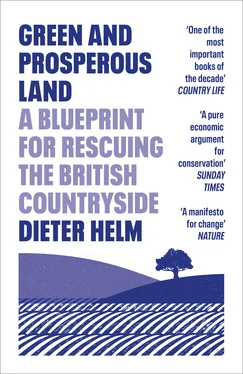While there are good reasons for particular campaigns and objections, something more is needed if the impacts are not to be seriously damaging to the natural environment. This requires not only a return to planning, but also the urgent application of the ‘net environmental gain’ principle to infrastructure and housing developments, properly and comprehensively measured.
It also requires an intelligent approach to technologies. Electricity transmission lines no longer need to be a blot on the landscape. They can go underground. Roads and railways can be fully digital. The need to travel to work can be tempered by video links and ever more efficient communications. The comprehensive roll-out of broadband and fibre could reduce the demands for other physical infrastructure. Better measurement and management of energy supplies and water can reduce demand too. It is possible (and in the above examples it is necessary) to improve infrastructure and at the same time protect and enhance the natural environment, but only with an integrated and planned approach. The unconstrained application of market forces will not deliver this.
The pressures of population growth, housing and infrastructure are multiplied through the rising levels of consumption. As GDP goes up, so does consumption. Indeed, most of the increases in economic growth in Britain are driven by spending ever more. Britain has a very high propensity to spend all of its income – and indeed more than its income – by increasing debt levels. In 2018, this was reflected in the average household spending £900 more than their income.[18]
Some numbers help to bring a perspective to this challenge. If GDP grows at 3 per cent per annum, it will double in less than 25 years. It is just the power of compound interest. Britain probably won’t quite make 3 per cent, but, as a rough guide, by 2050 a doubling is a plausible assumption to make.
Imagine what this would look like in 2050. Although the extra income would be spread over more people, think what you would spend twice your current income on. The better-off might buy bigger homes or even more second homes. The bulk of the population will buy more holidays, more clothes and more services. Most of this stuff has the potential to further damage the natural environment and create even more waste.
It is this that leads more radical greens to question whether we should be allowed to keep on spending so much or whether a more frugal lifestyle is required to ‘save the planet’. It is not hard to empathise with this sentiment. Looking beyond Britain, growth rates in China, India and increasingly in Africa are more like 5 to 7 per cent per annum. China has spent nearly 30 years growing at around 10 per cent per annum, which is a doubling of the size of its economy every seven years, and this is reflected in the new affluence of the emerging Chinese middle classes who now turn up in Britain in significant numbers as tourists. Whatever the benefits of all that extra consumption to the Chinese people, from a global environmental perspective, the spectacular GDP growth of China since 1980 has been a disaster for climate change, water resources, the state of the seas and for biodiversity. And it is one that continues to gather pace.
There are two dimensions to this extra consumption that impact on the natural environment: how much is spent; and what it is spent on. How much is spent should not be based on the 2 to 3 per cent GDP growth number, and there is a lot to be put right before economic growth can be accommodated, including the impacts of all the fiscal deficits, trade deficits and quantitative easing that pumped consumption up artificially high since the financial crisis of 2007/08. Current growth and spending levels are not sustainable: we are living beyond our means. It is not that these numbers cannot rise without damage to the environment. They can. Rather, it is that the numbers need first to be adjusted so that they are in fact sustainable.[19]
The amount of consumption growth after these corrections depends on technical progress, and there is lots more of this to come. Rebased, what will the resultant incomes be spent on? This depends on prices and planning. Current spending does not properly take account of all the external negative impacts on the environment – the externalities – and it should. What this requires is that these externality costs are reflected in the prices we pay online and in the shops. Food is artificially cheap because farmers do not pay for the pollution they cause. New houses are artificially cheap to build because the builders do not pay for all their wider impacts and the infrastructures they require. Packaged goods are artificially cheap because we don’t pay for all the cardboard and plastic. Once all these externalities are included – if the polluter-pays principle is properly applied – what we spend our money on may turn out to be rather different than business-as-usual suggests.
Business-as-usual is not a stable equilibrium, a world where we just live with the damage done in the twentieth century and allow it to worsen in this century. The damage is dynamic and, if allowed to run on, it will not bode well for the natural environment. More people, more houses, more physical infrastructure and more consumption is a world in which the chances that nature will hold its own are slim without action now. There will be some successes, but this is a world of instant gratification in almost all human activities.
The housing lobbyists argue that there is lots of land, and that building on more of it leaves lots left. Similarly they argue that the Green Belt is large, and a few more houses make little difference. Tracks up hillsides for wind farms, trucks to fish farms and cutting down a few ancient woodlands for HS2 are collateral damage for a claimed greater economic good.
This marginal argument, a marginal difference for each project and each marginal development, when set against a much larger whole plays out in business-as-usual. At each point along the way, one more housing estate is too small to make much difference to the whole. But it is a deadly argument. The trouble with this marginal argument is easy to see, but almost entirely ignored. Each time the marginal card is played there is a bit less left of the ecosystem and habitat of which it is a part. And so it goes on, until there is nothing left. In the words of the song by Joni Mitchell, ‘ you don’t know what you’ve got ’til it’s gone ’.[20] You will hear developers say that the Green Belt is not really very green anymore anyway because it has been intensively farmed. But why has it been intensively farmed? Because each new marginal addition to the chemical arsenal has been added on a case-by-case basis.
The tyranny of the marginal is the route to an increasingly silent spring. It is what business-as-usual means. Lots and lots of marginal losses end up with a catastrophe for insect life and for farmland birds. To seriously head off the damage that business-as-usual will bring – through more people, more houses and more hard infrastructures – the starting point needs to be the public goods, and not the marginal changes. It is these public goods that are being eroded in a death by a thousand cuts. Make no mistake, business-as-usual is likely to tip many ecosystems over the edge. By 2050 there could be very little left, and in a world with perhaps 500 or more parts per million of carbon in the atmosphere. The intensification of farming, industry, towns and cities could result in a silence of nature – of the birds, of the remaining insects and most of our mammals, reptiles, fish and invertebrates. It doesn’t have to be like this, but it will unless we act, and act now.
Читать дальше











